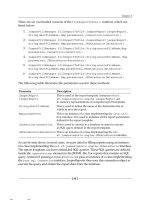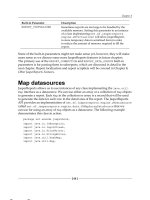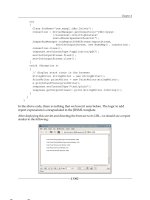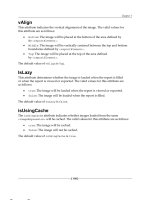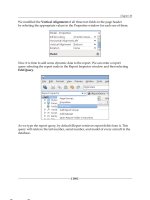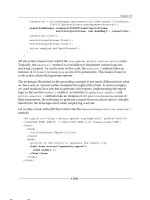jasperreports 3.6 development cookbook
Bạn đang xem bản rút gọn của tài liệu. Xem và tải ngay bản đầy đủ của tài liệu tại đây (21.25 MB, 456 trang )
www.it-ebooks.info
JasperReports 3.6
Development Cookbook
Over 50 recipes to create next-generation reports using
JasperReports
Bilal Siddiqui
BIRMINGHAM - MUMBAI
www.it-ebooks.info
JasperReports 3.6 Development Cookbook
Copyright © 2010 Packt Publishing
All rights reserved. No part of this book may be reproduced, stored in a retrieval system, or
transmitted in any form or by any means, without the prior written permission of the publisher,
except in the case of brief quotations embedded in critical articles or reviews.
Every effort has been made in the preparation of this book to ensure the accuracy of the
information presented. However, the information contained in this book is sold without
warranty, either express or implied. Neither the author, nor Packt Publishing, and its dealers
and distributors will be held liable for any damages caused or alleged to be caused directly
or indirectly by this book.
Packt Publishing has endeavored to provide trademark information about all of the companies
and products mentioned in this book by the appropriate use of capitals. However, Packt
Publishing cannot guarantee the accuracy of this information.
First published: June 2010
Production Reference: 1220610
Published by Packt Publishing Ltd.
32 Lincoln Road
Olton
Birmingham, B27 6PA, UK.
ISBN 978-1-849510-76-9
www.packtpub.com
Cover Image by Vinayak Chittar ()
www.it-ebooks.info
Credits
Author
Bilal Siddiqui
Reviewers
Nadeem Ghafoor Chaudhry
Sagara Gunathunga
Lloyd H. Meinholz
Bhavani P. Polimetla
Acquisition Editor
Dilip Venkatesh
Development Editor
Mayuri Kokate
Technical Editors
Ishita Dhabalia
Vinodhan Nair
Indexer
Monica Ajmera Mehta
Editorial Team Leader
Gagandeep Singh
Project Team Leader
Priya Mukherji
Project Coordinator
Zainab Bagasrawala
Proofreader
Sandra Hopper
Graphics
Geetanjali Sawant
Production Coordinators
Aparna Bhagat
Arvindkumar Gupta
Cover Work
Aparna Bhagat
www.it-ebooks.info
About the Author
Bilal Siddiqui is an Electronics Engineer, an XML consultant, and the founder of XML4Java.
com, a company focused on simplifying e-business. After graduating in 1995 with a degree in
electronics engineering from the University of Engineering and Technology, Lahore, he began
designing software solutions for industrial control systems. Later, he turned to XML and used
his programming experience in C++ to build web- and WAP-based XML processing tools,
server-side parsing solutions, and service applications. Bilal is a technology evangelist and
a frequently published technical author.
Bilal has been focusing exclusively on Java and XML-based open source tools and solutions
since 2006. He has extensively used popular open source products such as JasperReports,
ADempiere, Openbravo, and Eclipse. Bilal is a strong advocate of open source tools and is
engaged not only in designing solutions based on open source tools but also collaborating
with local universities in Lahore to train software and IT personnel in using open
source technologies.
Special thanks to my wife's patience, which was often put to the test while
I was working on this book. I'm also thankful for the support of Rainer
Maier—my friend and business partner, who was quite convinced that I
should just work on this book and sleep instead of working on our mutual
projects. Finally, I am also thankful to my colleagues, Tariq and Zia, for their
ideas to make this book more interesting and useful.
www.it-ebooks.info
About the Reviewers
Nadeem Ghafoor Chaudhry received his B.S. and M.S. in Computer Science from the
University of Massachusetts, Lowell, U.S.A. He worked in the software industry in the U.S. for
about four years. Then he switched to academia in Pakistan and taught both undergraduate
and graduate courses at different institutes of higher learning in Pakistan. Currently, he is
engaged as Assistant Professor in the department of Computer Science of COMSATS Institute
of Information Technology, Lahore, Pakistan.
COMSATS Institute of Information Technology (CIIT) is a renowned institute for higher learning
in Pakistan. Currently, the CIIT is offering 47 different degree programs divided into 20
undergraduate and 27 graduate programs in the elds of Information and Communication
Technology, Management Sciences, Electrical Engineering, Chemical Engineering, Mathematics,
Physics, Bio-sciences, Development Studies, Environmental Science, Meteorology, and
Architecture and Design. The present student strength is around 20,000 with faculty corpus
of more than 1,600. The CIIT has already produced approximately 10,000 graduates.
Sagara Gunathunga holds a special degree in Computer Science (B.Sc.) from the University
of Peradeniya, Sri Lanka and a degree in Information Technology (BIT) from the University of
Colombo, Sri Lanka. He is an Apache Axis PMC member, an Apache committer for several
projects that include Apache Web Service and Apache Woden. His research interest focuses
on SOA, web services, distributed systems, and modularity systems.
He also has a sound industry experience in J2EE-related technologies, including
ORM tools, dependency injection frameworks, and reporting. Currently, he is playing
a Tech-Lead role in a U.S based software services company named Aeturnum Inc.
Sagara also maintains his blog at
and you can get
in touch with him at
All my thanks go to my mother for supporting me.
www.it-ebooks.info
Lloyd H. Meinholz works as an IT professional in the Washington D.C. area. He has more
than 20 years of experience in developing software in a variety of programming languages
and production environments. Lloyd has focused on Java, Linux, and other open source
technologies for the past 12 years. He has been employed by start-up companies as well as
Fortune 500 companies and worked in both the public and private sectors. Lloyd has found
JasperReports and iReport to be a great reporting solution for many of his employers.
Bhavani P. Polimetla has been learning and working in the IT Industry since 1990. He
graduated as a Bachelor of Computer Science and Master of Computer Applications from
Andhra University, India. He worked on standalone Swing applications to Grid computing and
N-tire architecture. He has worked with the world's top clients including three from Fortune 50
companies. At present, he is working as an independent Java consultant in Atlanta, Georgia,
U.S.A.
To demonstrate his skills, he completed 25+ certications in the spectrum of J2EE, database,
and project management subjects. He also achieved many awards for many of his projects.
He reads and writes poetry in his free time. More information is available at his website
www.polimetla.com.
www.it-ebooks.info
Table of Contents
Preface 1
Chapter 1: Creating Static and Dynamic Titles and Headers 7
Introduction 7
Downloading, installing, and running JasperReports and iReport 8
Creating your rst "Hello World" report 10
Creating and sizing the title for your report 15
Using dynamic titles that can change during report processing 20
Inserting a company logo in the title of your report 25
Adding a simple header to your report 28
Setting margins for your report and aligning the report header relative
to report margins 34
Chapter 2: Working with the Body and Footer of your Report 41
Introduction 41
Displaying a eld along with its label in the body of your report and
handling null values 43
Creating a simple table of records along with labels for each column 51
Inserting a heading for a group of records 59
Using parameters to lter records during report processing 68
Implementing groups within groups — a nested hierarchy 73
Adding a simple footer to your report 81
Displaying general information or summary at the end of your report 90
Chapter 3: Enhancing the Look and Feel of your Report 99
Introduction 99
Deploying and reusing styles in your report 100
Setting background color for data 114
Using HTML tags and bullet lists 123
www.it-ebooks.info
ii
Table of Contents
Expanding a eld vertically to accommodate large text 135
Applying formatting pattern to the value of a data eld 140
Using background images and watermarks in your report 146
Chapter 4: Working with a Variety of Data Sources 151
Introduction 151
Creating a report from relational data 152
Connecting to an XML datasource 158
Creating a report from XML data using XPath 162
Using multiple relational databases to generate a report 171
Creating a report from model beans of
Java applications 184
Chapter 5: Multi-page Reports 195
Introduction 195
Building a cover page for your multi-page report 196
Creating a simple, one-page TOC for your report 201
Applying a style to your simple TOC 210
Resetting page numbering with the start of a particular record 218
Implementing complex multi-dimensional page numbering 228
Showing multiple types of data in the same report 239
Managing pagination of multiple types of data in a report 250
Chapter 6: Multi-column Reports 261
Introduction 261
Dividing the body of a report into multiple columns 261
Displaying groups of data in separate columns 266
Displaying data as name-value pairs in multiple columns 270
Filling your report horizontally in multiple columns 276
Using subreports to design a multi-column report 283
Chapter 7: Summary Report, Crosstabs, and Graphs 297
Introduction 297
Designing a simple summary report 297
Designing a multi-level summary report 303
Designing a crosstab—a table with dynamic rows and columns 315
Displaying data trends as a graph in your report 321
Embedding a bar graph inside a tabular view 331
www.it-ebooks.info
iii
Table of Contents
Chapter 8: Java Wrappers for your JasperReports 343
Introduction 343
Creating a Java wrapper for your report 344
Compiling and viewing your report in a Java Swing application 351
Printing the hardcopy of your report using a Java Swing application 357
Creating an Excel report from a Java Swing application 361
Creating a JasperReport on the y in a Java web application 366
Chapter 9: Using Mathematical and Logical Expressions
This chapter is not present in the book but is available as a free download from:
/>9.zip
Index 375
www.it-ebooks.info
www.it-ebooks.info
Preface
JasperReports is the world's most popular embeddable Java open source reporting library,
providing Java developers with the power to easily create rich print and web reports. While
such reports are pivotal in managing business information more effectively, creating and
customizing them can get tedious.
This book will give you recipes to solve common JasperReports problems to make your life
easier. It will take you through complex examples related to JasperReports with step-by-step
instructions on how to solve them.
The author's experience in creating reports enables him to share over 50 recipes to develop
crystal-clear business reports using the capabilities of JasperReports and the amazing
features provided by its visual report designer tool: iReport.
Create and enhance your business reports using the various functionalities of JasperReports
and iReport.
What this book covers
Chapter 1, Creating Static and Dynamic Titles and Headers, focuses on basic things such as
creating, sizing, positioning, and enhancing the titles and headers of the report.
Chapter 2, Working with the Body and Footer of your Report, covers working with the body and
footer of the report, including using parameters to lter records during report processing and
implementing nested hierarchy.
Chapter 3, Enhancing the Look and Feel of your Report, shows you how to enhance the look
and feel of your report by deploying and reusing styles, and by using designs, textual effects,
background images, and watermarks.
Chapter 4, Working with a Variety of Data Sources, focuses on advanced things such as
working with a variety of data sources: relational data, XML data, model beans of Java
applications, and also multiple relational databases at once.
www.it-ebooks.info
Preface
2
Chapter 5, Multi-page Reports, teaches you to build a cover page and table of contents
for multi-page reports, conditional reset page numbering, display multi-dimensional page
numbering, design multi-page reports using sub-reports, create separate header and footer
for each sub-report in your Master report, and much more.
Chapter 6, Multi-column Reports, covers topics such as dividing the body of a report in
multiple columns, grouping records with common value in a report column, lling data in
report columns horizontally and vertically, inserting column break in your report, controlling
the size of each column independently, and using sub-reports to design multi-column reports.
Chapter 7, Summary Report, Crosstabs, and Graphs, covers designing simple and multi-level
summary reports, cross-tabs with dynamic rows and columns, creating bar charts, embedding
a bar inside a tabular view, and displaying data trend graphs in your reports.
Chapter 8, Java Wrappers for your JasperReports, covers generating a report from a Java
Swing application, generating a report from your web application, printing a hard copy of a
report on the y from within your Java code, viewing your report as a PDF, or a web page, or
an XLS sheet, and so on.
Chapter 9, Using Mathematical and Logical Expressions, covers mathematical and logical
expressions such as counting the number of records with a particular eld value, grouping
records, applying styles to your data based on logical or mathematical conditions, and so on.
Chapter 9, Using Mathematical and Logical Expressions, is not present
in the book but is available as a free download from: http://www.
packtpub.com/sites/default/files/downloads/0769os-
chapter-9.zip
What you need for this book
The following software products are used in this JasperReports 3.6 Development Cookbook:
JasperReports version 3.6.0
iReport version 3.6.0
PostgreSQL version 8.4
Apache Tomcat version 6.0.16
Java Development Kit (JDK) version 1.6.0_12
Who this book is for
This book is for Java developers who want to use JasperReports to create user-friendly
business reports. It is for those who may be familiar with JasperReports but want to dive
into advanced JasperReports activities.
•
•
•
•
•
www.it-ebooks.info
Preface
3
If you know how to use Microsoft Word, you can also learn how to design business reports
using iReport by following the recipes of this cookbook.
Although the primary audiences of this cookbook are report designers, Java and XML
developers will nd this book useful in understanding how Jasper's XML code works and
how to wrap JasperReports functionality in your Java Swing or web applications.
Conventions
In this book, you will nd a number of styles of text that distinguish between different kinds of
information. Here are some examples of these styles, and an explanation of their meaning.
Code words in text are shown as follows: Open the Pattern.jrxml le from the Task5
folder in the source code for this chapter.
A block of code is set as follows:
<staticText>
<reportElement x="107" y="10"
width="340" height="33"/>
<textElement>
<font fontName="Verdana" size="24"/>
</textElement>
<text><![CDATA[Monthly Customer Invoices]]></text>
</staticText>
When we wish to draw your attention to a particular part of a code block, the relevant lines or
items are set in bold:
<jasperReport
<title>
<band height="94" splitType="Stretch">
<! other JasperReports XML tags >
<image>
<reportElement x="365" y="10"
width="180" height="80"/>
<imageExpression class="java.lang.String">
<![CDATA["X:\\Images\\packt.png"]]>
</imageExpression>
</image>
</band>
</title>
<! other JasperReports XML tags >
</jasperReport>
www.it-ebooks.info
Preface
4
Any command-line input or output is written as follows:
uncompress iReport-nb-xx.tar.gz
New terms and important words are shown in bold. Words that you see on the screen,
in menus or dialog boxes for example, appear in the text like this: "Select Currency from
the Category column and click the OK button."
Warnings or important notes appear in a box like this.
Tips and tricks appear like this.
Reader feedback
Feedback from our readers is always welcome. Let us know what you think about this
book—what you liked or may have disliked. Reader feedback is important for us to develop
titles that you really get the most out of.
To send us general feedback, simply send an email to
, and
mention the book title via the subject of your message.
If there is a book that you need and would like to see us publish, please send us a note in the
SUGGEST A TITLE form on
www.packtpub.com or e-mail
If there is a topic that you have expertise in and you are interested in either writing or
contributing to a book on, see our author guide on
www.packtpub.com/authors.
Customer support
Now that you are the proud owner of a Packt book, we have a number of things to help you
to get the most from your purchase.
Downloading the example code for the book
You can download the example code les for all Packt books you have
purchased from your account at .
If you purchased this book elsewhere, you can visit http://www.
PacktPub.com/support and register to have the les e-mailed directly
to you.
www.it-ebooks.info
Preface
5
Errata
Although we have taken every care to ensure the accuracy of our content, mistakes do happen.
If you nd a mistake in one of our books—maybe a mistake in the text or the code—we would be
grateful if you would report this to us. By doing so, you can save other readers from frustration,
and help us to improve subsequent versions of this book. If you nd any errata, please report
them by visiting selecting your book, clicking on
the let us know link, and entering the details of your errata. Once your errata are veried, your
submission will be accepted and the errata added to any list of existing errata. Any existing
errata can be viewed by selecting your title from />Piracy
Piracy of copyright material on the Internet is an ongoing problem across all media. At Packt,
we take the protection of our copyright and licenses very seriously. If you come across any
illegal copies of our works, in any form, on the Internet, please provide us with the location
address or web site name immediately so that we can pursue a remedy.
Please contact us at with a link to the suspected
pirated material.
We appreciate your help in protecting our authors, and our ability to bring you
valuable content.
Questions
You can contact us at if you are having a problem with any
aspect of the book, and we will do our best to address it.
www.it-ebooks.info
www.it-ebooks.info
1
Creating Static and
Dynamic Titles and
Headers
In this chapter, you will learn:
Downloading, installing, and running JasperReports and iReport
Creating your rst "Hello World" report
Creating and sizing the title for your report
Using dynamic titles, which can change during report processing
Inserting company logo in the title of your report
Adding a simple header to your report
Setting margins of your report and aligning the report header relative to
report margins
Introduction
This chapter is about the titles and headers of your reports.
Imagine you are looking for a particular recipe in a cookbook. Perhaps the quickest way of
doing this is to go through the table of contents, which is just a list of the titles of all the recipes
contained in this cookbook. So it is important that each title says what the recipe teaches.
Similarly, the title of your report will help identify the report among other reports. The title
perhaps decides the objective of designing a report.
www.it-ebooks.info
Creating Static and Dynamic Titles and Headers
8
A title normally appears on just the rst page of your report. The header appears on every
page. While a title helps to identify the report among other reports, a header distinguishes
the report among other copies of the same report. You can understand this with an example.
Consider you are designing a report showing the data for all invoices issued for a particular
customer during a specic month. "Monthly Customer Invoices" can be an appropriate title for
this report. Once you have designed the monthly customer invoices report, you will periodically
generate copies of this report for a specic customer and for a specic month (that is, each
copy of the report will be specic for these two parameters). Therefore, it is a good idea to
include these two parameters in the header of your report.
This means that a report header represents the data on which a report is generated.
Downloading, installing, and running
JasperReports and iReport
iReport is a powerful visual tool for JasperReports to graphically design reports. It is much
easier to generate JASPER code using the graphical features of iReport as compared to writing
the JASPER code by hand.
In order to create reports using JasperReports, you will only need to download iReport from
the iReport project website hosted at SourceForge.net (
/>projects/ireport
).
As the JasperReports library comes bundled with iReport, you don't need to separately
download and install JasperReports.
This recipe just shows you how to download, install, and run iReport.
How to do it
1. Visit the iReport project website at />ireport
. The iReport project homepage at SourceForge.net will open.
2. Click on the View all les button, and a list of all available versions of iReport will
appear. I used version 3.6.0 of iReport, which is the latest at the time of writing these
recipes. Therefore, expand iReport-3.6.0, by clicking on it. It will show all the les
related to iReport-3.6.0. Download the le named iReport-nb-3.6.0-windows-
installer.exe
. This is an executable le.
3. Double-click the Windows executable le. A setup wizard will run, which will show you
the installation steps and ask you for the folder where you want to install iReport. Just
provide the destination folder and the installation will nish.
www.it-ebooks.info
Chapter 1
9
4. After the installation is nished, iReport will run and show a welcome window. Click
on File and select New from the File menu. A New le dialog will appear containing
several icons such as Report, Style, Chart Theme, and so on. Each icon represents a
type of le you can create. The Report icon comes pre-selected, which means iReport
allows you to create reports by default.
5. Now your iReport is up and running and you are ready to try the recipes of
this cookbook.
There's more
The ve steps given above show you how to download and install iReport for Microsoft Windows.
iReport also supports other operating systems such as Linux, Mac OS X, and Solaris. The
following is a short guideline to download and install iReport for these operating systems.
Download and install iReport for Linux, Mac OS X, and Solaris
You can download iReport for Linux, Mac OS X, or Solaris by following the steps listed below:
1. Visit the sourceforget.net website at />ireport
. The iReport project homepage at SourceForge.net will open.
2. Click the View all les button, to the right of the Download Now! button. A page
will open containing the latest downloads for all operating systems in the Newest
Files section of the download page. You will nd that separate downloads of iReport
are available for Linux and Solaris as tar.gz les and for Mac OS X as DMG les.
Download iReport for your operating system.
3. For Linux and Solaris, you just need to unzip the iReport-nb-XX.tar.gz les
to your required folder. If you are using Linux, open the Linux Terminal and type the
following command in the terminal:
tar -zxf iReport-nb-xx.tar.gz
Visit
to learn more about unzipping tar.gz les.
If you are using Solaris, you will extract the package les with the uncompress
command, as shown below:
uncompress iReport-nb-xx.tar.gz
4. After you nish extracting the archive, run the ireport.exe le from the
iReport/bin folder.
www.it-ebooks.info
Creating Static and Dynamic Titles and Headers
10
Download older versions of iReport for Windows, Linux,
Mac OS X, or Solaris
If you need to download an older version of iReport, click on the View all les button to the
right of the Download Now! button on the iReport project home page. A page containing a list
of available versions will open. You will nd the latest downloads for all operating systems in
the Newest Files section and older versions in the All Files section of the download page.
Note that I have used iReport version 3.6.0 in this cookbook. iReport versions dated before
2008 are referred to as iReport classic, which might behave differently from the recipes of
this cookbook.
Creating your rst "Hello World" report
This recipe is a quick starter for someone who is using iReport for the rst time. It shows you
what views of your report the tool offers and what type of report components are available.
This recipe also teaches you how to quickly make a simple "Hello World" report.
How to do it
The following ten steps will show you how to make your rst "Hello World" report.
1. Run iReport. Click on File and select New from the File menu. A New le dialog
will appear, which contains several icons such as Report, Style, Chart Theme, and
so on. Each icon represents a type of le you can create. The Report icon comes
pre-selected, which means iReport allows you to create reports by default.
2. Click on the Report icon on the top-left corner of the New le dialog. You will see
a number of report templates available to start building your report.
www.it-ebooks.info
Chapter 1
11
3. Select the Blank A4 report template and click the Open this Template button at the
bottom. Blank A4 is the simplest of all templates and, therefore, is a good starting
point to learn iReport.
4. Next, you will be prompted to enter a lename for your report. Specify a name of
your choice. I call my rst report ASimpleBlankA4Report, as shown next. Click
the Next button.
5. The Finish dialog will appear saying that you have successfully created your new
report. Click on Finish to dismiss it.
6. iReport will open your blank report in its default view, which shows three tabs:
Designer, XML, and Preview. The Designer tab shows the various sections of your
report such as Title, Page Header, Column Header, and so on, as shown in the
following screenshot:
www.it-ebooks.info
Creating Static and Dynamic Titles and Headers
12
7. You will see a Palette of alphabetically arranged components (for example, a break, a
chart, a static text, or a text eld component) on the right of the main iReport window,
as shown next. Drag a Static Text component from the Palette and drop it into the
Title section of your report. Similarly drag-and-drop another Static Text component
into the Page Header section of your report.
8. Double-click on the Static Text component of the Title section and type Hello World
in it as shown:
9. Click on the XML tab, which shows the JasperReports XML (JRXML) code that
iReport authors in response to your designer actions in the Designer tab. You will see
that XML code for JasperReports changes every time you drag-and-drop a component
from the palette into the designer view of your report.
www.it-ebooks.info
Chapter 1
13
10. Finally, switch to the Preview tab, which shows what your "Hello World" report will
actually look like:
How it works
JasperReports has dened its own XML-based markup language called JasperReports XML, or
JRXML for short. JRXML code contains all the information that is required to specify everything
about your report. Therefore, designing a report using JasperReports means you have to
perform the following steps:
1. Write JRXML code manually according to the requirements of your report.
2. Parse and compile the JRXML code to generate a JASPER le for your report.
3. Combine your JASPER les with application data to generate your report view.
This process is called lling.
4. Export your report view to a popular format such as PDF or XLS.
You normally need to write Java code to compile, ll, and export your JasperReport.
iReport is a JRXML authoring, compiling, lling, and exporting tool. This means that if you can
author JRXML manually and write Java code to perform these tasks (compiling, lling, and
exporting), you don't need iReport.
However, it is really troublesome trying to write JRXML manually. The graphical tools and
components in iReport make it very easy and quick to author the JRXML according to the
design requirements of your reports. iReport performs the following tasks for you to help
you generate your report:
1. As a visual authoring tool, it helps you to generate JRXML by just dragging-and-
dropping of components. It actually translates your visual actions to JRXML code.
2. It compiles the JRXML to generate a JASPER report le.
3. It also combines JASPER les with application data to generate a print preview for
your screen and printer.
4. Then it may export this report preview to a popular format such as PDF or XLS.
www.it-ebooks.info
Creating Static and Dynamic Titles and Headers
14
iReport provides three integrated views to make your work easier: the designer view (where
you design your report graphically), the preview view (where you can see the effects of your
design), and the XML view (where you can view and edit the actual XML of a JRXML le).
To see the XML view of iReport, switch to the XML tab and you will nd the following JRXML
code for the Blank A4 report:
<?xml version="1.0" encoding="UTF-8"?>
<jasperReport>
<background><band splitType="Stretch"/></background>
<title>
<band height="79" splitType="Stretch"/>
</title>
<pageHeader>
<band height="35" splitType="Stretch"/>
</pageHeader>
<columnHeader>
<band height="61" splitType="Stretch"/>
</columnHeader>
<detail>
<band height="125" splitType="Stretch"/>
</detail>
<columnFooter>
<band height="45" splitType="Stretch"/>
</columnFooter>
<pageFooter>
<band height="54" splitType="Stretch"/>
</pageFooter>
<summary>
<band height="42" splitType="Stretch"/>
</summary>
</jasperReport>
You can see from this code that there is a JRXML tag for every section of your report. For
example, there is a <title> tag which wraps the title of your report. Similarly, you can
see a <pageHeader> tag, which wraps the header.
Each JRXML tag for a section has a <band> child, which species two things about the
section: the height of the section through a height attribute and the splitting behavior
of the section.
In steps 8, 9, and 10 of this recipe, you played a little with the Designer, XML, and Preview
tabs, respectively. You will need these tabs in almost every report you prepare using iReport.
www.it-ebooks.info


